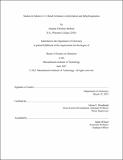Studies in Selective C-C Bond Formation via Borylation and Dehydrogenation
Author(s)
Barbour, Johanna Christine
DownloadThesis PDF (978.8Kb)
Advisor
Wendlandt, Alison
Terms of use
Metadata
Show full item recordAbstract
Three stories of C-C bond formation are presented. First, we attempt to harness the Lewis acidity of boron to induce chemo- and regioselectivity in two fundamental organic reactions (Chapter 1). We explore 1,2-difunctionalization of alkenes via formation of a three-membered cyclic intermediate with the goal of adding various Lewis bases to control the intermediate’s direction of ring opening (Chapter 1.2). Unfortunately, the tunability of this system remains to be studied, as we were unable to confirm the formation of this intermediate.
Secondly, we look to employ the hyperconjugative stability afforded by boron to adjacent alkyl radicals. We demonstrate room temperature regioselective alkylation of pyridazines by (iodomethyl)boronic acid pinacol ester in the presence of trifluoroacetic acid in up to 70% yield (Chapter 1.3). We see that this reaction proceeds upon variation of either the halide identity or the length of the alkyl fragment, indicating the a-boryl group is the only essential factor.
Finally, we demonstrate photocatalytic acceptorless dehydrogenation of unactivated hydrocarbons (Chapter 2). Using a dual catalytic system with sodium decatungstate and a cobaloxime catalyst, we separate dehydrogenation into two discreet hydrogen atom abstraction events. The first C-H bond breaking event is achieved by photoexcited decatungstate. The C-H bond b- to the resultant alkyl radical is significantly weakened, and now susceptible to activation by cobalt to give the product alkene. We demonstrate this strategy is successful for aromatization of a number of unactivated alkenes in up to 96% yield.
Date issued
2021-06Department
Massachusetts Institute of Technology. Department of ChemistryPublisher
Massachusetts Institute of Technology